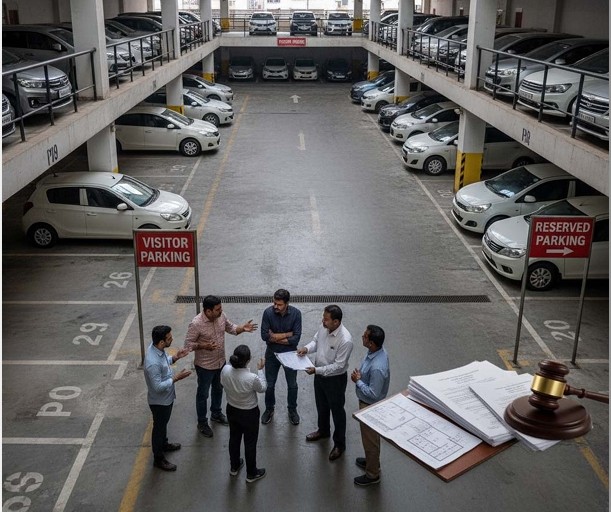If you live in an apartment, you probably already know that parking is one of the hottest topics in any residential community. Who gets how many slots? Can builders really charge extra? What about visitor parking?These questions often lead to disputes—not only between residents and developers, but sometimes even among neighbors themselves. And most of these conflicts come down to one thing: a lack of awareness about what the law actually says.In this post, we break down the rules, court rulings, and RERA guidelines that govern parking rights in housing societies.
🏗️ BBMP Building Bye-Laws (2003)
The BBMP has laid down minimum standards for parking in Bengaluru’s residential projects:
- • Cars: At least 18 sq. m. (3 m × 6 m) per car.
- • Two-wheelers: At least 2.5 sq. m. (1.25 m × 2 m).
- • Cycles: At least 1.5 sq. m. (0.75 m × 2 m).
For high-rise buildings, parking may be allowed in setback areas—but only after leaving a 6-meter clear space around the building for fire tender access. As for how many slots should be provided:
- • One slot for every two homes up to 50 sq. m. (538 sq. ft.).
- • One slot for each home between 50–150 sq. m. (538–1615 sq. ft.).
- • Beyond 150 sq. m., one slot for every additional 100 sq. m. (1076 sq. ft.).
⚖️ Supreme Court’s Landmark Ruling
In 2010, the Supreme Court gave a landmark judgment in Nahalchand Laloochand Pvt. Ltd. vs Panchali Co-operative Housing Society. The verdict made things crystal clear:
- • Builders cannot sell parking spaces separately.
- • Open and stilt parking are part of a society’s common areas.
- • Parking spots are not independent saleable units—they belong to the society, not the builder.
This judgment was rooted in the Maharashtra Ownership of Flats Act (MOFA), 1963, which requires all common areas to be disclosed and handed over to the housing society.
📜 What RERA Says About Parking
The Real Estate (Regulation and Development) Act, 2016 (RERA) took these protections further by defining parking more clearly:
- • Open Parking: Must appear in the sanctioned project plan, but cannot be sold separately.
- • Stilt Parking: Considered a common area, owned by the society.
- • Covered Garage: A fully enclosed garage (with walls, roof, and a door) can be sold—but only if it’s approved in the sanctioned plan.
- • Transparency Rule: Builders must disclose parking details upfront and allot them fairly.
🚫 Common Parking Disputes in Apartments
Despite clear rules, disputes still crop up, such as:
- • Builders charging extra for open or stilt parking.
- • Unfair or unclear allocation of slots.
- • Some residents getting multiple spaces while others are left without.
- • Visitor parking being misused by residents.
✅ How Residents Can Protect Their Rights
If you’re a buyer or resident, here’s how you can safeguard yourself:
- • Check Your Agreement: Ensure parking terms are mentioned in your sale deed.
- • Verify the Plan: Look at the sanctioned plan filed with RERA to confirm the actual number of slots.
- • Know Your Rights: Remember—open and stilt parking spaces are not for sale.
- • Take Action if Needed: File a complaint with RERA or the consumer forum if rules are violated.
🏡 Final Thoughts
Parking may seem like a small issue, but it has a big impact on community living. Thankfully, the Supreme Court’s ruling and RERA provisions have brought much-needed clarity and fairness.
For residents, the key is awareness—know your rights before signing any agreement. For societies, the solution is transparency—allocate fairly to avoid unnecessary conflicts.
👉 At SYSTEQIndia, we believe that when developers and residents follow the law and communicate openly, communities become happier, more harmonious, and stress-free.
